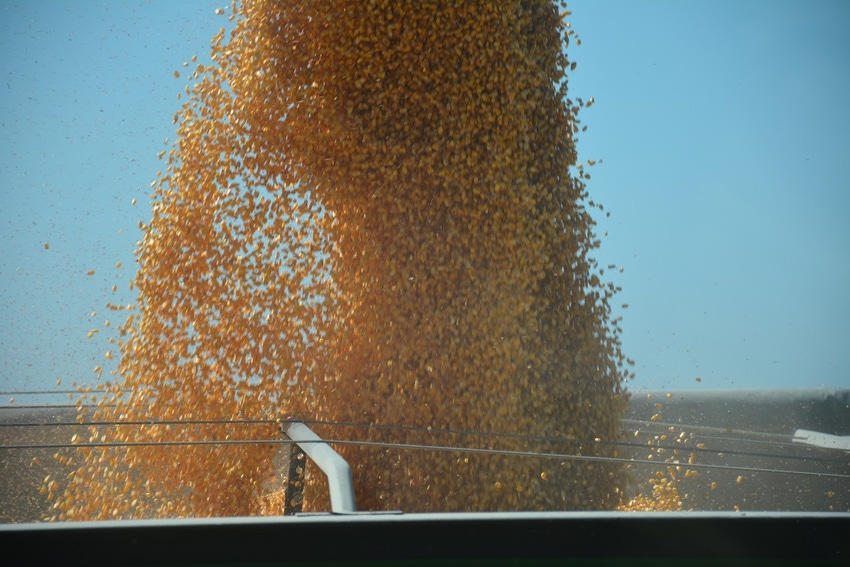
Record corn crop straining trucking in Northeast Texas
Jim Swart, retired Texas A&M AgriLife Extension specialist and now executive director for the Cereal Crops Research Incorporated (CCRI) says the Northeast Texas region has had ample rainfall all during the growing season. “I don’t think spring crops ever stressed for moisture,” he says.

Northeast Texas farmers are harvesting a dryland corn crop that most believe will break yield records by a large margin.
��“It’s the best crop I’ve ever made,” says Ronnie Lumpkins, Leonard, Texas. “It’s hard to estimate since we’re just about half through, but I think it will average from 160 to 180 bushels, per acre.”
“That’s about 100 bushels more than normal,” adds his daughter, Lana. “This is pretty good crop,” echoed Ronnie’s son, Brad, who had just come in with a drone and was pulling up images of the combine making its way across one of their best fields. “If we can get it out,” he added.
Longtime employee Jose (Cowboy) Munoz offered this reporter a combine ride and said this is by far the best corn he has ever harvested. Munoz pointed to the yield monitor displaying on-the-go and average yields. At times the real-time yield number jumped above 200 bushels per acre and field average stood at a near constant 180.
“On one side of the field, where we started, we were making only150 bushels,” Munoz says. “This side is much better.”
What’s the difference? “The soil is weak on the other side,” he said. “This soil is much better.”
Munoz says moisture has been plentiful all season. “I’ve never combined corn in the mud before.” He was also using a four-wheel drive combine.
The Blacklands area received heavy rain in August, delaying harvest and causing some concern about lodging. That has not been an issue so far. “We received 6 inches of rain here August 12,” Lana said. “Another field got 9 inches and another had 12 inches—all that within 7 miles of our farm headquarters. We got another 2 inches August 12,” she says. “We see a lot more weather extremes than we used to,” she adds. “Weather has changed so much since I was old enough to notice it.”
Jim Swart, retired Texas A&M AgriLife Extension specialist and now executive director for the Cereal Crops Research Incorporated (CCRI) says the Northeast Texas region has had ample rainfall all during the growing season. “I don’t think spring crops ever stressed for moisture,” he says.
Lumpkins says cotton, grain sorghum, and soybeans also show promising yields.
About 40 miles south, near Wylie, Texas, Ben Scholz was sitting in the cab of his combine, talking on his smart phone, trying to find an available truck to take on his corn so he could get back to harvesting. “I’m short some trucks and short some help,” Scholz explained as he crawled off his machine. “I guess it’s a good problem to have,” he says.
BEST CROP EVER
He agrees that this will be the best corn crop he’s ever made, and figures yields will run from 125 to 150 bushels per acre. “I think a 130-bushel average will be a good bet,” he says. “You will talk to others who will make more, but that’s a good dryland corn yield.”
Swart says Northeast Texas corn yields in general will likely set records. He suspects grain sorghum yields will also come in high when harvest begins in the next few weeks. “And we seem to have the best cotton prospects we’ve had in years.”
Scholz says weather for all the spring-planted crops has been favorable. “Not the case for wheat. We were off on our wheat, averaging about 45 to 50 bushels, decent but not what we have been used to the last few years. We got a little spoiled.”
Scholz says the only thing he might have done differently to this crop would have been to spray something for rust. “We’ve got quite a bit of rust,” he says.
He’s also planning some changes for next year, going to a stale seedbed and placing potassium, about 60 percent to 80 percent of it, under the row about 6 inches deep.
On this day, however, what he really needed was another semi-truck, but he was thankful that he had fields full enough of corn to create a transportation backlog.
About the Author(s)
You May Also Like





